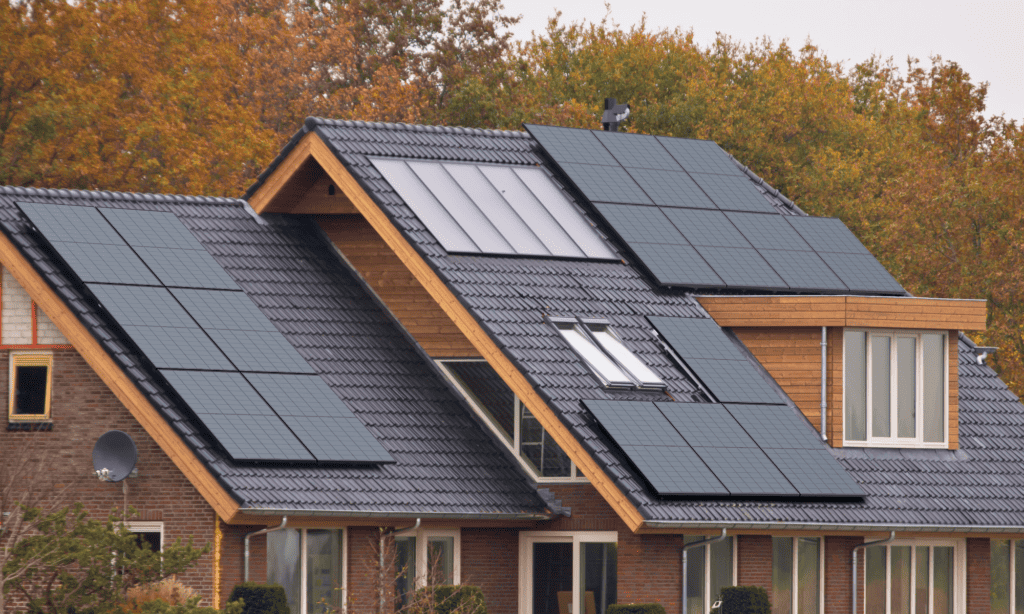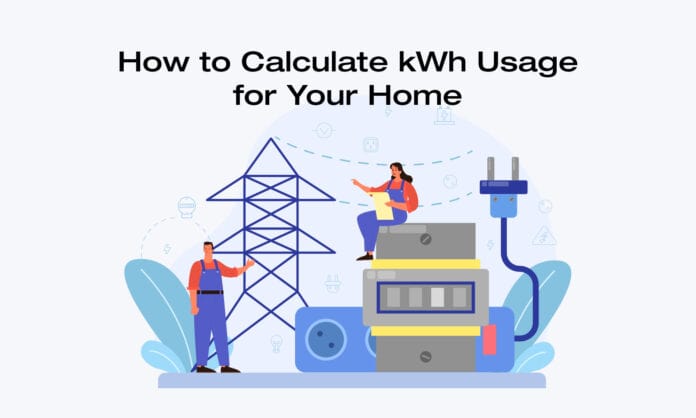Table of Contents
Can you imagine life without electricity?
From keeping our homes warm (or cool) to cooking and keeping our food fresh to watching TV…
Modern life runs on kilowatts.
Do you know how much electricity your home consumes daily? If you’re on the grid, you’ll undoubtedly know how much it costs you every month… But have you ever calculated your electricity consumption in kilowatt-hours (kWh)?
Knowing your total energy consumption is essential if you’re considering switching to solar power or another form of renewable energy to meet some or all of your electricity needs. In fact, it’s the first step in determining what kind of system you need.
Read on to learn how to calculate the electricity consumption in kilowatt-hours (kWh) of your appliances and your home.
Understanding kW and kWh
Having a basic understanding of watts (W), watt-hours (Wh), kilowatts (kW), and kilowatt-hours (kWh) is essential for assessing electricity generation and consumption requirements.
Most household appliances measure the electricity required to start and run in watts (wattage). For example, the average household refrigerator uses 700W but may need 2000W to start up. Many large household appliances — especially anything with a motor — require 2-3 times as much electricity to turn on than to run. This additional wattage is referred to as surge power or starting wattage.
A kilowatt measures larger amounts of electricity consumption and production. One thousand watts is equal to one kilowatt.
Watts and kilowatts are units of power that indicate the rate of electricity consumed or produced at a specific moment in time.
Watt hours (Wh) and kilowatt-hours (kWh) are units of power that measure electricity consumed or generated over a period of time (1 hour).
Essentially, watts and kilowatts indicate the “rate” of electricity production or consumption. Watt-hour and kilowatt hours give you the “total” amount of electricity generated or consumed over time.

Calculating Kilowatt Hours (kWh) Using Wattage
Converting watts to kilowatt-hours might seem intimidating, but it’s actually a simple process.
Whether you’re looking to learn more about everyday appliances, portable power stations, or whole home generators, knowing how to calculate total electricity consumption based on the wattage of your devices and household systems (like HVAC) is essential.
Again, using the 700W fridge as an example, it will consume 700Wh hourly when it’s running.
Wattage x Hours of Operation = Watt-Hours (wH) or Kilowatt hours (kWh)
A fridge is one of the major appliances you’ll run 24 hours a day, so it’s a good place to start. Using the formula above, here’s how to calculate its daily electricity consumption.
700W x 24 (hours) = 16.8 kWh
Remember, this doesn’t account for the surge power required to turn the fridge on. Additionally, many modern fridges don’t operate at full wattage all the time. To conserve electricity, the cooling mechanism only turns on when the interior temperature drops below a fixed point.
Nevertheless, it’s a useful example of how to calculate electricity consumption based on an appliance’s operating wattage and convert it to watt-hours/kilowatt hours based on how long you’ll use it each day.
Calculate Daily Electricity Consumption by Converting Watts to kWh
Wattage indicates the electricity a device needs to operate. Watt-hours and kilowatt-hours measure the amount of electricity it consumes over time.
Calculating your home’s electricity consumption is essential, especially if you’re considering generating your own power off-grid.
Without knowing how many appliances you want to run simultaneously — and for how long — it’s impossible to determine the answers to questions like what size solar generator or how many solar panels you need.
To determine your household’s average daily energy consumption in kilowatt-hours, follow this method:
- Identify Device Power Ratings: Start by listing all major electrical appliances in your home and their power ratings, typically found on the device or its manual, and expressed in watts or kilowatts.
If the power requirements are listed in amps or volts, you can use the below equation to calculate the running watts of an appliance:
Volts (V) x Amps (A) = Watts (W)
- Determine Average Daily Usage: Estimate how many hours each appliance operates daily. Some appliances, like refrigerators, run all day. Other devices, like microwaves, might only be used for a few minutes.
- Calculate Individual Device Consumption: For each appliance, multiply its power rating (in kW) by its daily usage (in hours) to get daily energy consumption in kWh.
kWh = Watts Hours of Operation
- Sum Up Total Daily Consumption: Add the daily kWh figures for all appliances to get your household’s total daily energy consumption. For instance, if you have a washing machine rated at 1500W (1.5kW) and you run it for 2 hours daily, it consumes:
1.5kW x 2 hours = 3kWh
Repeat this calculation for all devices, and then total the results to get your daily household consumption.
- Review and Refine: Periodically, compare your calculated values with your electricity bill to ensure accuracy and make adjustments as necessary.

Calculating Electricity Consumption for Going Off-Grid
The above method is useful if you simply want to calculate your average daily electricity consumption.
However, if your goal is determining how much electricity you need to generate to take some (or all) of your home off-grid, you must factor in starting watts (surge power).
Some solar generators can deliver up to double their AC output in short bursts to get high-wattage appliances up and running. However, fossil fuel generators can typically only deliver around 10% of surge power above their AC output.
Taking starting wattage into account is essential to making an informed purchase of an off-grid power solution.
Here’s how to do it.
- Identify the wattage requirements of your appliances. Survey the starting and running wattage requirements of the appliances and devices you plan to plug into the generator. You can usually find the wattage requirements labelled on the appliance, but we’ve also compiled the starting and running watts of typical household appliances in the table below.
- Convert volts/amps to watts. If your appliance’s power requirements are in volts or amps, you can calculate an appliance’s running watts with this equation:
Volts (V) x Amps (A) = Watts (W)
- Count the running watts of your appliances. Add up the running watts of the appliances you plan to use — does the total exceed the running watts listed on your generator? If so, consider buying a generator with more output capacity.
- Factor in starting watt requirements. Identify the appliance with the highest starting wattage. Add that appliance’s starting wattage to the running wattage total.
- Calculate the sum. That final number is the total starting watts you need from your generator. As discussed above, to avoid overloading your generator, do not exceed its starting watts rating.
Starting and running wattage varies widely by manufacturer and model. But here’s a table of average starting and running wattages of common household appliances.
Starting and Running Watts of Typical Household Appliances
| Appliance | Rated (Running) Watts | Starting Watts |
| Dishwasher | 1300W | 1800W |
| Washing Machine | 1200W | 2300W |
| Refrigerator/Freezer | 700W | 2200W |
| Light Bulb | 60-75W | 0 |
| Microwave | 600-1000W | 0 |
| TV | 500W | 0 |
| Toaster | 900W | 0 |
| Vacuum | 1440W | 2500W |
| Coffee Maker | 1000W | 0 |
| Blender | 300W | 800W |
| Clothing Iron | 1500W | 0 |
| Dryer | 5400W | 7000W |
| Toaster Oven | 1200W | 0 |
| Curling Iron | 1500W | 0 |
| Space Heater | 2000W | 0 |
| Laptop | 50-300W | 0 |
| 20” Box Fan | 200W | 350W |
What Is the Watt-Hour and KWh Usage for Common Household Items?
Every appliance in your home, from your smartphone to your air conditioner, contributes to your overall energy consumption. The combined electricity your devices consume impacts everything from your utility bills to the size of the solar generator and the number of solar panels you’d need to go off-grid.
As mentioned above, the running wattage required by appliances of the same type — say, a washing machine or blow dryer — varies widely by manufacturer.
However, we’ve compiled a table of common household appliances along with average wattages and consumption over a 3-hour period just to give you an idea of what your usage might look like.
Remember, you can calculate your kWh using running kilowatts with the below formula:
Wattage x Hours of Use = Electricity Consumption (Wh/kWh)
Electricity Consumption (kWh) of Typical Household Appliance Over 3 Hours
| Appliance | Rated (Running) Wattage | kWh Consumed over 3 Hours |
| Dishwasher | 1300W | 3.9 kWh |
| Washing Machine | 1200W | 3.6 kWh |
| Refrigerator/Freezer | 700W | 2.1 kWh |
| Light Bulb | 60-75W | 0.18 – 0.225 kWh |
| Microwave | 600-1000W | 1.8 – 3 kWh |
| TV | 500W | 1.5 kWh |
| Toaster | 900W | 2.7 kWh |
| Vacuum | 1440W | 4.32 kWh |
| Coffee Maker | 1000W | 3 kWh |
| Blender | 300W | .9 kWh |
| Clothing Iron | 1500W | 4.5 kWh |
| Dryer | 5400W | 16.2 kWh |
| Toaster Oven | 1200W | 3.6 kWH |
| Curling Iron | 1500W | 4.5 kWh |
| Space Heater | 2000W | 6 kWh |
| Laptop | 50-300W | 0.15 kWh – .9 kWh |
| 20” Box Fan | 200W | .6 kWh |
Frequently Asked Questions
A typical UK household consumes an average of 8 kWh of electricity per day. This number fluctuates based on the season, household size, appliance usage, and regional differences in energy consumption.
The amount of electricity a 2,000 sq ft home uses varies widely based on numerous factors, including climate, number and type of appliances, construction, number of residents, and more — not just its size. You might find that your 2,000 sq ft house generally consumes around 25-40 kWh per day, but everyone’s consumption will vary.
Monthly electricity consumption in a 2,000 sq ft household depends on factors other than size, including climate, number and type of appliances, construction, number of residents, and more. The average UK household consumed 240kWh of electricity monthly in 2021.
The electricity consumption in a house depends on other factors in addition to size, including climate, number and type of appliances, construction, number of residents, and more. You might find that your 1,000 sq ft house consumes 15-25 kWh per day (approximately 450-750 kWh per month), but your usage may also fall below or above this range. The average UK household consumed 240kWh of electricity monthly in 2021.
Final Thoughts
Understanding how to calculate electricity consumption is pivotal in today’s energy-conscious world — especially if you’re considering switching to clean, renewable solar energy.
A basic grasp of wattage and watt-hours is essential for assessing the energy footprint of household appliances and your home’s consumption as a whole. Knowing the basics of how electricity is measured allows us to make smarter choices, both environmentally and financially.
With EcoFlow’s advanced solar and home backup battery technology, it’s never been easier to monitor your electricity consumption — and to go off-grid with solar!
Dive into Ecoflow’s range of products today and power your home with smarter, greener energy solutions today!







